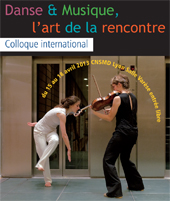
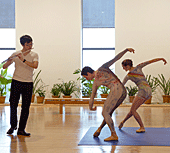
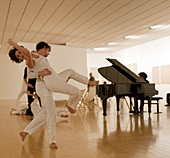
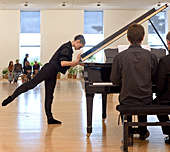
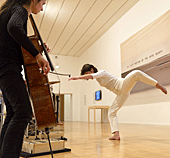
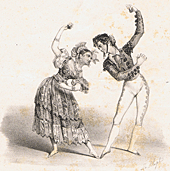
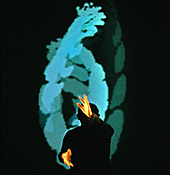
- aFont size -
- AFont size +
- PrintPrint this page
- version pdfPage in PDF format
Events
International symposium
“Dance and Music : the Art of the Encounter”, 16th, 17th and 18th April 2013 (Lyon).
The international colloquium on the theme of “Dance and Music : the Art of the encounter” which was held on 16 – 18 April 2013 is the second event of its kind organised by the Lyon CNSMD.
The three-day colloquium was devoted to the problems encountered when dance and music meet, sometimes on film, and examined under many different angles. When can one of these art forms be said to take precedence over the other ? Can they ever be combined into one ? Is ‘independence’ the key word ? The colloquium attempted to answer these questions by taking a new look at the relationship between music and dance, using examples that have marked the different periods from the Renaissance to today.
The days were puntuated by performances of music, notably music for film, and dance (in grey in the program).
Biennial colloquium is organised by the Lyon Conservatoire National Supérieur Musique et Danse. Scientific organising committee is chaired by Emmanuel Ducreux.
There have always been many meeting points between dance and music, which have taken on many different forms and senses and have often been symptomatic of the evolution of the thought and the sense of culture and ideas in a given society. Examples of this are the relations between dancing masters and composers during the 16th and 17th centuries, the emergence of the opéra-ballet and the stylisation of dance forms, via the recollection of their rhythmic formats, which characterised the instrumental suites of the 17th and 18th centuries. More recently, there have been the famous relationships between choreographers and composers such as that of Balanchine and Stravinsky, or associations such as those of John Cage and Merce Cunningham and of Thom Willems and William Forsythe. From the end of the 19th century onwards and throughout the 20th century the number of encounters of this type has constantly increased.
From the beginnings of the cinematograph the early film-makers showed a passionate interest in dance movement, as can be seen in the first films of Edison and the Lumière brothers. Hollywood very soon took over the stage musical and made it into a new form of cinema in its own right. Similarly numerous operas have been the subjects of cinema productions. Dance and music are woven together in many different ways in films devoted neither to dance nor to music. Finally, after several decades, films of dance have been elevated to the rank of works of art and composers frequently include projected images in their stage works.
TUESDAY 16 APRIL
1.30 p.m. : official opening by Géry Moutier, Director, and Emmanuel Ducreux, Chair of the Department of Musical Culture.
President, Alain Poirier
The Debussy-Nijinsky encounter : fusion or discordance ?
Muriel Joubert, Lumière University Lyon 2.
Les Ballets suédois and music : a situation of contradictions.
Sabine Vergnaud, Centre Interdisciplinaire d’Etudes et de Recherches sur l’Expression Contemporaine (CIEREC) Saint-Etienne.
Concerning some famous people involved in encounters between music and improvised dance in fiction cinema.
Gilles Mouëllic, Rennes 2 University.
Liberating sounds and movements : the shared aesthetics of John Cage and Merce Cunningham.
Anne de Fornel, Paris-Sorbonne University.
4.00 p.m. break
4.15 – 6.00 p.m.
MAC Reminiscence, choreographic workshop diriged by Dominique Genevois. Sébastien Libolt, Jory/Jothy : Shazam, John Cage, Atlas Eclipticalis for flutes. With Maxime Bordessoules, Gabriel Fillatre, Renaud Garros, Randy Lopez, Joséphine Meunier, Amlmendra Navarro, Jade Orgeas, Benoît Peillon, Garegin Pogossian, Eva Rauch, Emma Saide, Margaux Tonder and Ana Torrealba, dancers.
President, Martin Barnier
Sketch for a theory of the relations between dance and music in multi- and inter-media practice.
David Revill, University of Maryland (USA).
Speaking the image. An experiment.
Jean-Philippe Guye, Lyon CNSMD.
Sacrifice and silence in the works of Luigi Nono and Andreï Tarkovski.
Charlotte Ginot-Slacik, Lyon CNSMD, doctorand at the University of Rouen.
WEDNESDAY 17 APRIL
9.00 a.m. :
Musicians who dance by the Department of Early Music of the CNSMD. Music prepared by Martial Morand. Programme of French dances from the 15th to the 17th century. Works by D’Eustache du Caurroy, De La Barre, Pascal Collasse and Jean-Philippe Rameau.
President, Pierre Saby
Movement, metre et musicality in la belle danse (from 1680 to 1795).
Dora Kiss, doctorand at the University of Geneva and the University of Nice-Sophia Antipolis.
Concerning the fine and educated cadence : examples from theatre repertoire recorded at the beginning of the 18th century.
Hubert Hazebroucq, Association pour un Centre de Recherche sur les Arts du Spectacle aux XVIIe et XVIIIe siècles (ACRAS), University of Reims.
10.45 a.m. break
11.00 a.m. – 12.30 p.m. :
Benjamin D’Anfray, piano : R. Schumann, Davidsbundlertänze op. 6, pieces 1 – 6
President, Florence Poudru
Concerning some articles devoted to dance in the Encyclopédie by Diderot and d’Alembert.
Alban Ramaut, Jean Monnet University, Saint-Étienne.
Final encounter. Marguerite and Armand, Frederick Ashton’s ultimate hommage to Fonteyn and Noureyev.
Giuseppe Montemagno, University of Catania (Italie).
1.30 p.m. break
1.45 p.m. :
Alice Szymanski, flute : Stockhausen, Zungenspitzentanz (Tip-of-the-Tongue Dance) for solo piccolo.
President, Alain Poirier
Music and dance from the end of the Middle Ages to the Renaissance : the transition from ‘music to which people dance’ to ‘music for dancing’.
Welleda Muller, Paris-Sorbonne University.
When contemporary choreographers move into opera : Orpheus and Eurydice by Pina Bausch and Dido and Aeneas by Sasha Waltz.
Stéphane Sawas, Institut National des Langues et Civilisations Orientales (INALCO) Paris & Ecole Normale Supérieure (ENS).
3.00 p.m. break
3.15 p.m. :
Galdric Subirana, percussion and Frank Gizycki, dance : Xenakis Psappha
President, Emmanuel Ducreux
Algorithmic and aesthetic inter-relations in the dance piece Stocos.
Pablo Palacio, Zurich University of the Arts.
An example of cosmic dance in the contemporary choreographic landscape : the dancing body and the body of sound in the work of Anne-Teresa de Keersmaeker.
Sarah Di Bella, Paris West University Nanterre – La Défense.
Le Marteau sans maître (The Hammer without a Master), or how Béjart discovers Artaud in the music of Boulez.
Antony Desvaux, doctorand at Paris 8 University.
5.00 p.m. break
5.15 – 6.30 p.m.
Composition by Hugo Gonzalez for the film « The Love of Zero » (Robert Florey, 1927), CNSMD instrumental ensemble.
President, Frank Langlois
The ballet music of Nikos Skalkottas seen as a representation of aesthetic issues in Greece between 1930 and 1940.
Lorenda Ramou, doctorand at the Paris CNSMD and at Paris-Sorbonne University (Paris IV).
The sociological ingredients of musical alchemy. The articulation of dance and music in the creative process for the revival of the ballet La Source at the Paris Opera.
Laura Cappelle, doctorand at Paris 3 Sorbonne Nouvelle University.
THURSDAY 18 APRIL
9.00 a.m.
Consort Brouillamini (Aranzazu Nieto, Elise Ferrière, Virginie Botty, Florian Gazagne, recorders) : works by Purcell and J.S. Bach
President, Florence Poudru
Noverre : the maître de ballet and 18th century music.
Françoise Dartois-Lapeyre, Centre Roland Mousnier research laboratory, Paris -Sorbonne University & Paris IUFM (Institut Universitaire de Formation des Maîtres : University teacher training institute).
Ballet in opera : the example of Don Giovanni by Mozart and Da Ponte at the Académie de Musique (1805 and 1834).
Séverine Féron, University of Burgundy.
1917-1918, L’Homme et son Désir by Claudel, Milhaud and Parr : an anthropological leap forward.
Frank Langlois, Lyon CNSMD.
11.00 a.m. break
11.15 a.m. – 12.30 p.m.
Héloïse Mas, mezzo-soprano and Mathilde Verolles, soprano, Jean-Marc Lesage, piano : works by Bizet, Saint-Saëns and Fauré.
President, Frank Langlois
What the cinema does to dance: performances of kabuki in Japanese silent films and the first talkies.
Simon Daniellou, Rennes 2 University.
Gypsy bodies and sonorities in the camera of Tony Gatlif.
Charlotte Riom, Getulio Vargas Foundation, Rio de Janeiro (Brazil).
1.30 p.m. break
1.45 – 3.30 p.m.
Open Mind : improvised chamber music by the Lyon CNSMD improvisation workshop, artistic coaches Jean-Marc Foltz and Henri-Charles Caget.
President, Martin Barnier
Moments of transgression : improvised dance in non-musical films.
Gaëlle Lombard, Paris West University Nanterre-La Défense.
Writing for gesture and movement in the works of Karlheinz Stockhausen in the seventies and eighties (Inori, Harlekin, Kathinkas Gesang).
Emmanuel Ducreux, Lyon CNSMD & Paris CNSMD.
Physique and choreographic metaphysics in the musicals of Max Ophuls.
Philippe Roger, Lumière University Lyon 2.
3.30 p.m. : concluding session.
4.00 p.m. : end of the proceedings.
9.00 p.m. : Light Music Performance : Jean Geoffroy, solo conductor and Franck Berthoux, technical coordination.
The papers of this international colloquium were presented in French or in English and interpreters translated the presentations in other languages.
Scientific committee :
Martin Barnier – Lyon 2 University
Jean-Claude Ciappara – Lyon CNSMD
Marc Desmet – Jean Monnet- Saint Etienne University
Emmanuel Ducreux – Lyon CNSMD/ Paris CNSMD
Jean Geoffroy – Lyon CNSMD
Dominique Hervieu – Maison de la Danse et Biennale de Lyon
Géry Moutier – Lyon CNSMD
Alain Poirier – Lyon CNSMD
Florence Poudru – Lyon CNSMD
Béatrice Ramaut-Chevassus – Jean Monnet- Saint Etienne University
Pierre Saby – Lyon 2 University
Downloads
Programme du colloque international
Direct access


